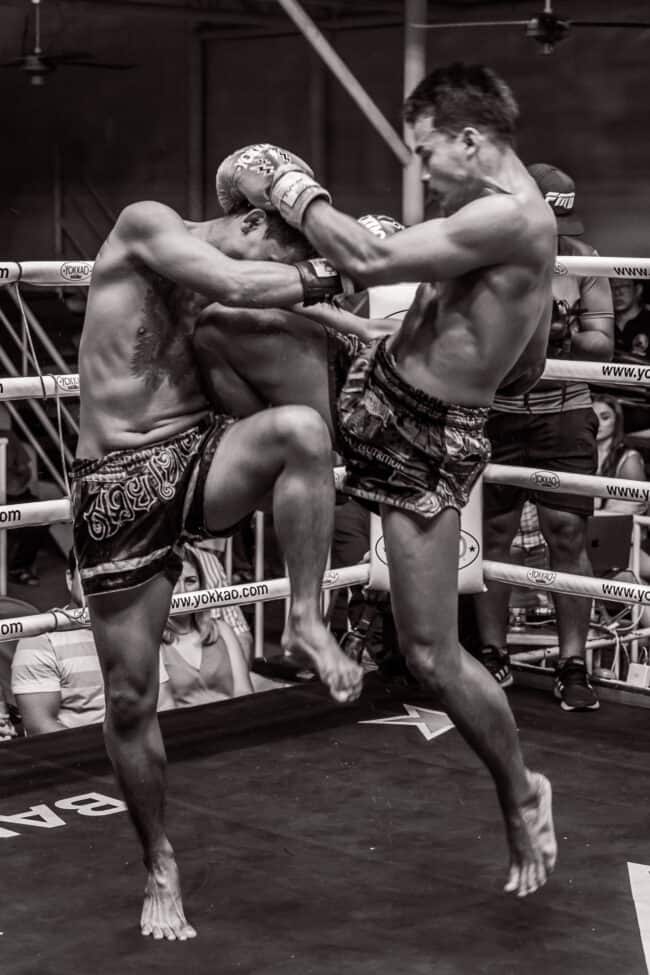
A Beginners Guide To Muay Thai
For those that want to learn Muay Thai, this blog gives you a great summary of the history of the sport and how to get involved.
Where does Muay Thai originate from?
Muay Thai, also known as Thai boxing, is a combat sport originating from Thailand. It is believed to have developed from various forms of indigenous martial arts practiced in the region, and it has a long and rich history that dates back hundreds of years.
One of the earliest records of Thai Boxing dates back to the 16th century, when it was used by Thai soldiers in warfare. Over time, it evolved into a popular combat sport, and it was practiced by both the upper classes and the common people. In the 20th century, Muay Thai gained international recognition and became a popular martial art and combat sport around the world. Today, it is one of the most popular martial arts practiced globally, with millions of practitioners in countries across the world.

What are the rules of Muay Thai?
Muay Thai, also known as “the art of eight limbs”, has a set of rules that govern the way the fights are conducted. Here are the basic rules of:
- Ring dimensions: The ring used is usually square-shaped and measures between 6-7.2 meters on each side. The ring must also have three ropes to separate the fighters from the audience.
- Weight classes: Fighters are classified into different weight classes to ensure a fair match. The weight classes are similar to other combat sports, such as boxing.
- Attire: Fighters are required to wear shorts, gloves, and a mouthguard during the fight.
- Rounds: Fights are divided into 5 rounds, usually lasting 3 minutes each.
- Scoring: Judges score the fight based on the effectiveness and technique of the strikes, kicks, and knees. The fighter who lands the most effective strikes and shows the most skill in their technique will win the round.
- Techniques: Fighters are allowed to use their fists, elbows, knees, and shins to attack their opponent. However, strikes to the groin, spine, or the back of the head are not allowed.
- Clinching: Fighters can use a technique called clinching, where they grab onto their opponent and use their knees and elbows to strike. However, clinching for more than a few seconds is not allowed, and the referee will separate the fighters.
- Knockouts: A fighter can win by knockout, where their opponent is unable to stand up and continue fighting after a ten-count. The fight can also end in a decision, where the judges score the fight.
- Fouls: Fighters can be penalized or disqualified for fouls such as hitting their opponent when they’re down, biting, headbutting, or using unsportsmanlike conduct.
Muay Thai is a highly skilled and intense sport that requires discipline, strength, and technique. Fighters must adhere to these rules to ensure a fair and safe competition.

Where is Muay Thai practiced today?
Thai boxing is practiced all over the world. It is particularly popular in Thailand, where it originated and where it is the national sport. Muay Thai has also gained popularity in other parts of Southeast Asia, including Cambodia and Laos, as well as in other regions such as Europe, North America, and Australia.
In recent years, the sport has gained significant international exposure due to the growing popularity of mixed martial arts (MMA) competitions such as the Ultimate Fighting Championship (UFC), which often feature fighters with a background in Muay Thai.
Overall, Thai Boxing is practiced by both professional athletes and amateurs in gyms and training facilities around the world.

What are the benefits?
Here are some of the benefits of practicing Thai Boxing:
- Improved fitness: Muay Thai is an intense workout that can improve your overall fitness. It can increase your cardiovascular endurance, strength, flexibility, and balance.
- Self-defense: Muay Thai is an effective form of self-defense that teaches you how to strike and defend yourself in real-life situations.
- Stress relief: Muay Thai can be a great way to relieve stress and release tension. The physical activity and mental focus required in Muay Thai can help reduce anxiety and improve mood.
- Increased confidence: Muay Thai can help increase your confidence and self-esteem as you become more skilled in the sport.
- Discipline and focus: Muay Thai requires discipline and focus, which can help improve your concentration and mental clarity in other areas of your life.
- Social connections: Muay Thai is often practiced in a group setting, which can help you make new social connections and develop a sense of community.
Overall, practicing Muay Thai can offer physical and mental benefits that can enhance your quality of life.

How can I get started?
If you’re interested in getting started in Muay Thai, here are some steps you can take:
- Find a gym or training facility: Look for a gym or training facility in your area. You can search online or ask for recommendations from friends or family.
- Attend a trial class: Most gyms offer trial classes where you can try out Muay Thai and see if it’s something you enjoy. Take advantage of these classes to get a feel for the training and to see if the gym is a good fit for you.
- Get the right gear: The sport requires some specialized equipment, including gloves, hand wraps, shin guards, and a mouthguard. Your gym may have some gear available for use, but it’s best to invest in your own equipment for hygiene and fit.
- Learn the basics: The first few weeks of training will likely focus on teaching you the basics of, such as proper stance, footwork, and striking techniques. Pay attention to your instructor and practice regularly to improve.
- Build your fitness: Muay Thai requires a high level of fitness, so it’s important to build your stamina and strength. You can do this by attending Muay Thai classes regularly and supplementing with cardio and strength training outside of class.
- Be patient: Learning takes time and practice, so don’t get discouraged if you don’t see progress immediately. Keep working hard and you’ll see improvement over time.
Remember to always listen to your body and take breaks as needed. Thai Boxing is a challenging martial art, but it can also be incredibly rewarding. With dedication and hard work, you can become a skilled Muay Thai practitioner.
Have you ever wanted to travel to Thailand to train? Check out what Sumalee Boxing Gym, Phuket has to offer.



